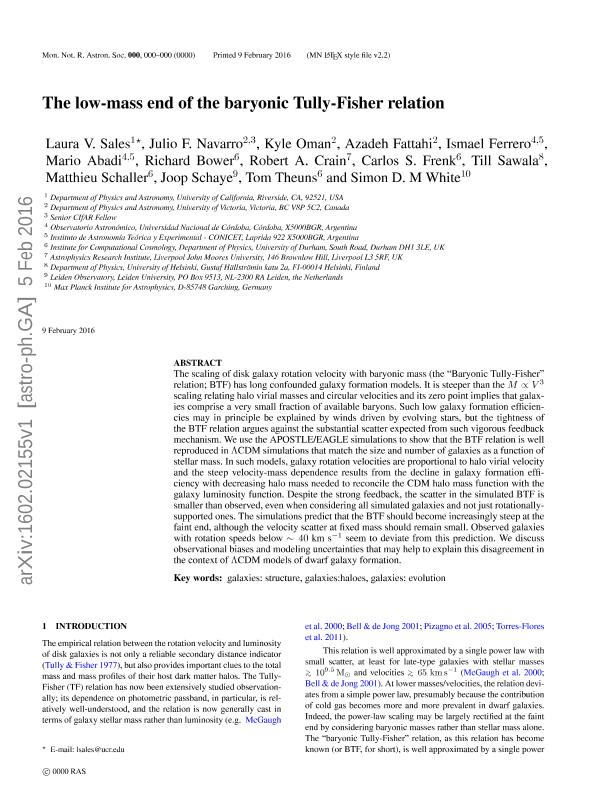Artículo
The low-mass end of the baryonic Tully-Fisher relation
Sales, Laura Virginia ; Navarro, Julio F.; Oman, Kyle; Fattahi, Azadeh; Ferrero, Santiago Ismael
; Navarro, Julio F.; Oman, Kyle; Fattahi, Azadeh; Ferrero, Santiago Ismael ; Abadi, Mario Gabriel
; Abadi, Mario Gabriel ; Bower, Richard; Crain, Robert A.; Frenk, Carlos S.; Sawala, Till; Schaller, Matthieu; Schaye, Joop; Theuns, Tom; White, Simon D. M.
; Bower, Richard; Crain, Robert A.; Frenk, Carlos S.; Sawala, Till; Schaller, Matthieu; Schaye, Joop; Theuns, Tom; White, Simon D. M.
 ; Navarro, Julio F.; Oman, Kyle; Fattahi, Azadeh; Ferrero, Santiago Ismael
; Navarro, Julio F.; Oman, Kyle; Fattahi, Azadeh; Ferrero, Santiago Ismael ; Abadi, Mario Gabriel
; Abadi, Mario Gabriel ; Bower, Richard; Crain, Robert A.; Frenk, Carlos S.; Sawala, Till; Schaller, Matthieu; Schaye, Joop; Theuns, Tom; White, Simon D. M.
; Bower, Richard; Crain, Robert A.; Frenk, Carlos S.; Sawala, Till; Schaller, Matthieu; Schaye, Joop; Theuns, Tom; White, Simon D. M.
Fecha de publicación:
01/2017
Editorial:
Oxford University Press
Revista:
Monthly Notices of the Royal Astronomical Society
ISSN:
0035-8711
Idioma:
Inglés
Tipo de recurso:
Artículo publicado
Clasificación temática:
Resumen
The scaling of disc galaxy rotation velocity with baryonic mass (the 'baryonic Tully-Fisher' relation, BTF) has long confounded galaxy formation models. It is steeper than the M ∝ V3 scaling relating halo virial masses and circular velocities and its zero-point implies that galaxies comprise a very small fraction of available baryons. Such low galaxy formation efficiencies may, in principle, be explained by winds driven by evolving stars, but the tightness of the BTF relation argues against the substantial scatter expected from such a vigorous feedback mechanism. We use the APOSTLE/EAGLE simulations to show that the BTF relation is well reproduced in Λcold dark matter (CDM) simulations that match the size and number of galaxies as a function of stellarmass. In such models, galaxy rotation velocities are proportional to halo virial velocity and the steep velocity-mass dependence results from the decline in galaxy formation efficiency with decreasing halo mass needed to reconcile the CDM halo mass function with the galaxy luminosity function. The scatter in the simulated BTF is smaller than observed, even when considering all simulated galaxies and not just rotationally supported ones. The simulations predict that the BTF should become increasingly steep at the faint end, although the velocity scatter at fixed mass should remain small. Observed galaxies with rotation speeds below ~40 km s-1 seem to deviate from this prediction. We discuss observational biases and modelling uncertainties that may help to explain this disagreement in the context of ΛCDM models of dwarf galaxy formation.
Palabras clave:
Galaxies: Evolution
,
Galaxies: Haloes
,
Galaxies: Structure
Archivos asociados
Licencia
Identificadores
Colecciones
Articulos(IATE)
Articulos de INST.DE ASTRONOMIA TEORICA Y EXPERIMENTAL
Articulos de INST.DE ASTRONOMIA TEORICA Y EXPERIMENTAL
Citación
Sales, Laura Virginia; Navarro, Julio F.; Oman, Kyle; Fattahi, Azadeh; Ferrero, Santiago Ismael; et al.; The low-mass end of the baryonic Tully-Fisher relation; Oxford University Press; Monthly Notices of the Royal Astronomical Society; 464; 2; 1-2017; 2419-2428
Compartir
Altmétricas



